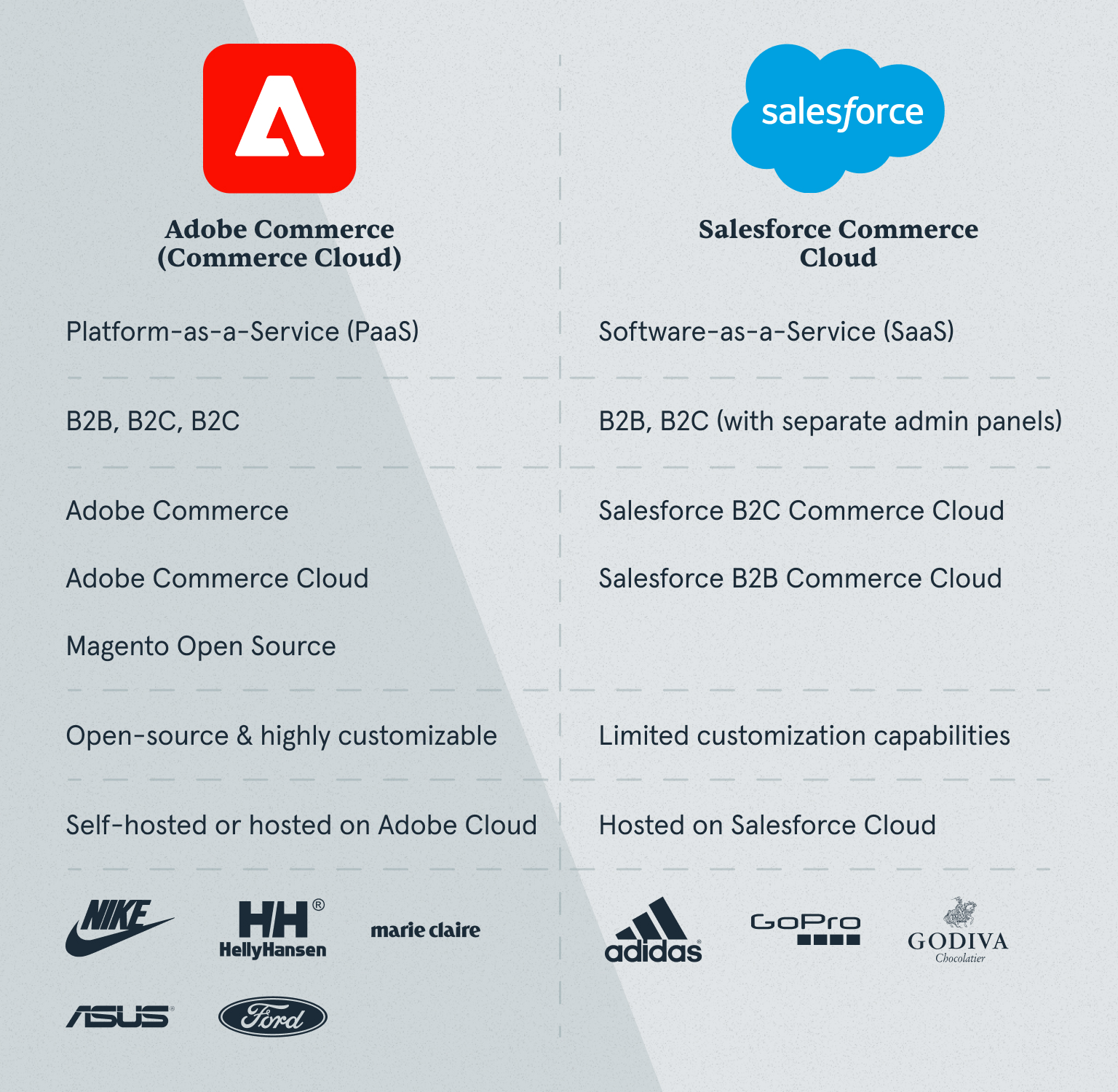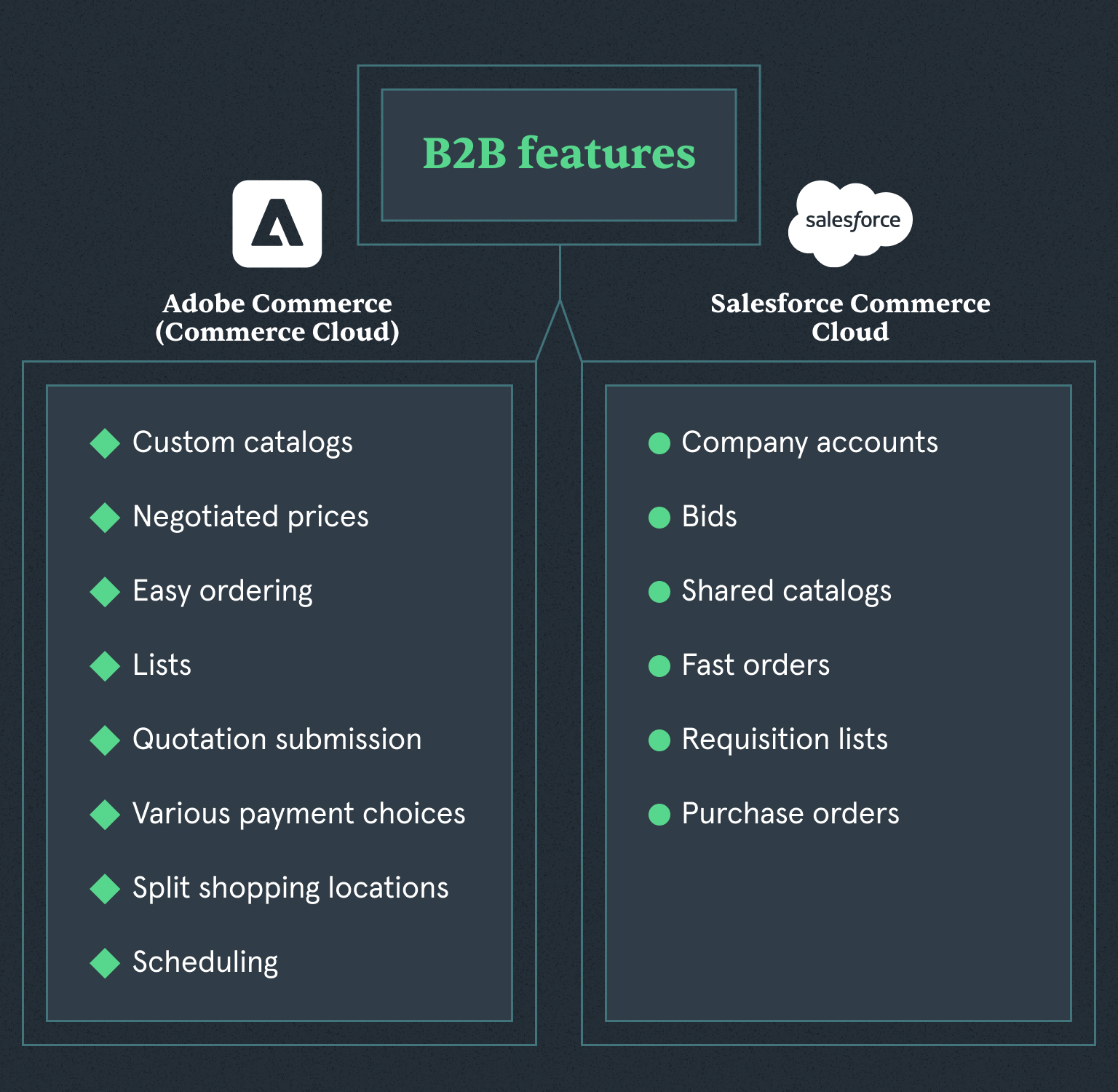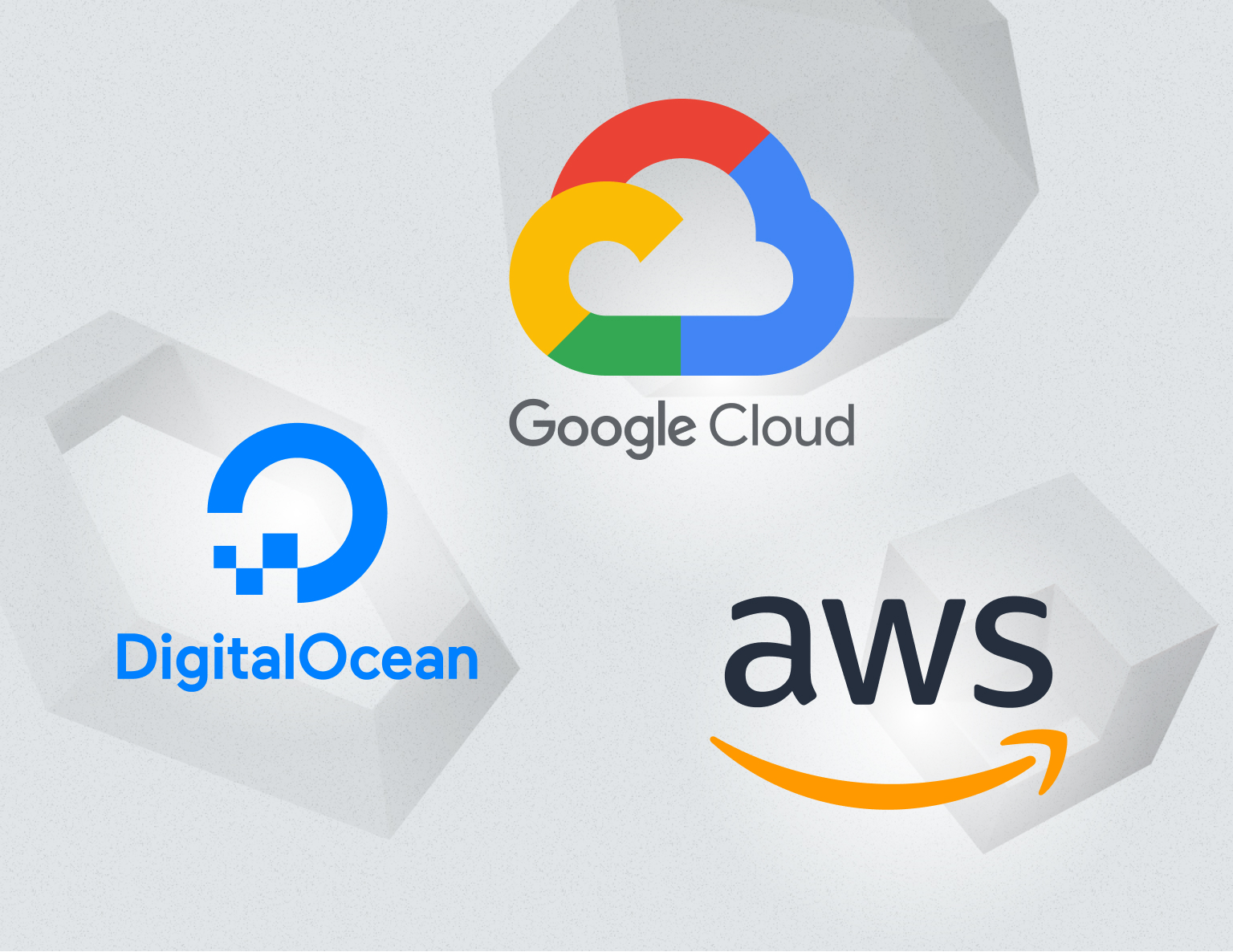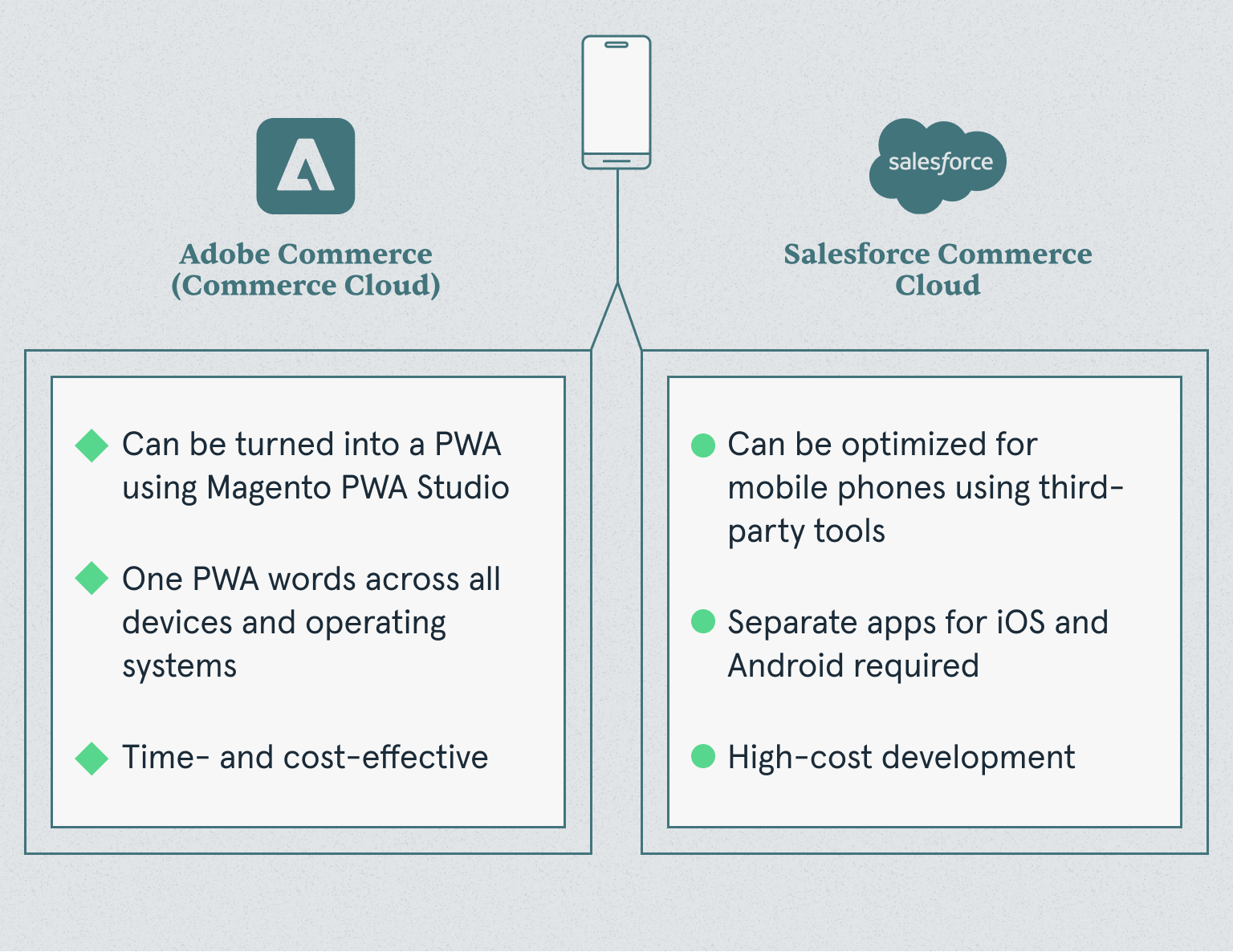The eCommerce platform is the foundation of your online shopping business. Your online store's success will depend on your business model's compatibility and the platform you choose.
Magento Commerce and Salesforce Commerce Cloud are two industry-leading platforms offering unique and creative features to online eCommerce stores. As of today, Magento accounts for around
12% of all online stores.We will go through their capabilities, cost, scalability, and more to help you decide which one caters to your business needs.
Adobe Commerce vs Salesforce: Platform Types
Let’s start with the core difference between the two services.
Adobe Commerce
Adobe Commerce, previously known as Magento Commerce, is a Platform-as-a-Service that is available in two versions. Adobe Commerce is an on-premise version, and Adobe Commerce Cloud is a cloud-hosted version. Thanks to its open-source nature, merchants fully control the platform and its features. They can easily tweak and expand the platform with additional functionality based on business needs and requirements.
Adobe Commerce supports eCommerce operations of small, medium, and enterprise-level companies worldwide. Nike, Helly Hansen, Marie Claire, and a great many other well-known brands rely on Adobe Commerce. Our customers – Restaurant Supply, EvolutionsBrands, and RenovatorStore – also chose Adobe Commerce to power their eCommerce storefronts.
Salesforce Commerce Cloud
Salesforce Commerce Cloud is a Software-as-a-Service platform that caters to the needs of both large and medium-sized eCommerce businesses. It works well as a ready-to-use service since the service provider takes care of servers, hosting, networks, and even cybersecurity, so customers don’t have to worry about it.
Because Salesforce Commerce Cloud is a SaaS platform, you’ll get limited access to the server and source code. This makes it almost impossible for users to change the code and customize features to suit their own requirements.
Salesforce Commerce Cloud is distributed in two versions to serve different industry models: Salesforce B2C Commerce and Salesforce B2B Commerce. Companies such as Adidas, GoPro, and Godiva rely on the platform in their eCommerce operations.
We will break down the unique characteristics of the two platforms further in the article. Check out our video to get a quick overview of the two platforms.
Magento vs Salesforce: Pricing Comparison
Price is an important factor when choosing a platform. So let’s explore how Magento vs Salesforce Cloud compare when it comes to their pricing models.
Adobe Commerce Pricing
Magento pricing differs depending on the three versions you choose among.
Magento Open Source is free, while the licensing costs of Adobe Commerce and Adobe Commerce Cloud start at $22,000 and $40,000, correspondingly. The final price will depend on your company’s Annual Gross Revenue (AGR). You can always get in touch with Adobe, and they’ll provide you with the cost for your business.
Additionally, Adobe Commerce offers a flexible payment method to new customers. It allows them to make monthly payments for the platform throughout the first year. However, this is merely the platform’s cost. If you decide to use Adobe Commerce, you’ll also need to factor in additional costs for hosting, development, design, quality assurance, and other related fees. Hiring a Magento development agency with in-depth platform knowledge can save development expenses in the long run.
The total cost of Magento Commerce provides you with access to many additional features, such as advanced Page Builder, B2B capabilities, and more.
There are several advantages to making a one-time purchase, but perhaps the most valuable is the freedom and versatility you get in managing and designing your website. You can also start with Magento Open Source and then move to Adobe Commerce or Adobe Commerce when you need B2B or other features provided by the paid version.
Don’t know how much Magento website development will cost?
Read our guide on Magento development cost to learn how to make sure you’re not overpaying for eCommerce website development.
Salesforce Commerce Pricing
Sales Commerce is the more costly option between the two platforms, and calculating its cost is a bit complex. The pricing system for Salesforce Commerce is based on the Gross Merchandise Value, and around 2 to 3 percent of the GMV is paid by eCommerce businesses. This makes it difficult to calculate the estimated cost of using the service, and Salesforce ownership expenses may occasionally be quite unexpected.
Budget planning is challenging because prices change regularly and rise in line with your company’s expansion.
Magento Commerce Cloud vs Salesforce: Industry Model
What eCommerce industry model are you operating in?
Is it B2B, B2C, or D2C? Or maybe you operate across all of them?
This is a critical question to answer beforehand since Salesforce and Adobe Commerce are drastically different in this department.
Salesforce Commerce
Although it was initially designed for B2C service, Salesforce Commerce now offers both Salesforce B2C Commerce and Salesforce B2B Commerce models. Salesforce acquired both Demandware & CloudCraze and expanded its platform with B2B functionality.
Due to a lack of available options, establishing a unified B2B and B2C experience on a Salesforce Commerce Cloud website is more complex than you may think. If you want Salesforce Commerce Cloud to run B2B2C, you must either buy a second license, modify their current one, or create two different websites to match the requirements. You will have two different backends and admin panels for managing B2B and B2C transactions. And integrating these new features will undoubtedly cost you more money and time to make your website functional.
B2B features of Salesforce Commerce Cloud are:
- Custom catalogs
- Negotiated prices
- Easy ordering
- Lists
- Quotation submission
- Various payment choices
- Split shopping locations
- Scheduling
Adobe Commerce
It is the industry’s go-to choice Because Adobe Commerce offers B2B capability right out of the gate. Businesses from B2C, B2B, and D2C are available under one Adobe Commerce Cloud umbrella. Furthermore, All the tools you need to expand your business are included in a single payment. Adobe Commerce B2B features include:
- Company accounts
- Bids
- Shared catalogs
- Fast orders
- Requisition lists
- Purchase orders
Additionally, you have the option to customize them according to your requirements and integrate new ones as well.
Based on the features alone, both platforms are a good choice if you operate in the B2B or B2C market. However, since Adobe Commerce Cloud is an all-in-one package, it is better suited if you operate across all models simultaneously.
Magento vs Salesforce: Extensibility & Flexibility
Let’s dive deeper into the customization features of both platforms and compare Magento integration with salesforce.
Magento Commerce
Magento is an open-source platform offering greater freedom and flexibility to store owners and developers. This feature allows you to rapidly scale up in response to increased customer demand.
There are also thousands of extensions available both from Adobe and third-party vendors. You can easily add new functionality and integrations without spending hundreds of hours on custom development. And you can still create your own solutions and reuse them across multiple projects.
Adobe Commerce is an ideal solution for you if your business needs creative solutions.
Salesforce Commerce
When compared to Magento, Salesforce Commerce Cloud offers a lot less in terms of customization and flexibility. The SaaS nature of the platform allows users to only make so many changes. As a result, opportunities to improve services and introduce new ones are constrained. It is difficult to add new features, modify current ones, and change platforms to suit your company’s demands.
Salesforce Commerce Cloud has very few extensions compared to Adobe Commerce. Though the most critical integrations, such as payment gateways, marketing integrations, and so forth, are available.
Salesforce Commerce Cloud is better suited for businesses that are not looking for many customizations and whose demands can be satisfied by standard capabilities.
Adobe Commerce vs Salesforce Commerce Cloud: Hosting
Hosting is the backbone of an eCommerce store. It can impact a lot of things – from performance to website scalability and security. Let’s compare the two platforms in this regard.
Salesforce Commerce
Salesforce Commerce Cloud comes packed with hosting. There is no need for you to be concerned about selecting, setting up, or managing a hosting service. Salesforce will be responsible for the maintenance and support of your servers.
Adobe Commerce
Like Salesforce, Adobe Commerce Cloud version is hosted, with the corporation handling all aspects of hosting on your behalf. Adobe’s hosting includes a number of bonus features, such as auto-scaling to handle traffic spikes during busy eCommerce times and PCI compliance for secure transactions.
Adobe Commerce allows you to choose a hosting service of your liking. In general, Adobe gives you greater leeway in running your company as you see fit.
If you start with Magento Open Source and then switch to Adobe Commerce, you can keep using the same web hosting.
Magento vs Salesforce: Business Intelligence
Let’s see how Magento vs Salesforce Commerce Cloud compare against each other when it comes to business intelligence functionality. Both systems use Machine Learning and AI to power their respective business intelligence tools.
Adobe Commerce
Adobe Business Intelligence is based on the Adobe Sensei Artificial Intelligence system. This system compiles data from a wide variety of resources—social media, CRM systems, sales records, and so on—into a centralized location and then offers a wide variety of pre-designed report formats to display the information. You get a comprehensive overview of your business activities.
Additional features include:
- AI-driven product suggestions
- Recommendations are displayed to your customers based on their activities, such as browsing history, purchasing habits, and product interests
Adobe Commerce BI is a standalone add-on with its own price tag. But the features make it completely worth it.
Salesforce
Salesforce Commerce Cloud operates on Einstein, its proprietary AI system. It comes built-in with the platform services, so you don’t have to pay an additional fee for it. Its key features are:
- consumer behavior analytics
- product recommendations
- automatic search and category tailoring based on every action shoppers make
Artificial intelligence (AI) and other sophisticated features are included in both Salesforce Commerce Cloud and Adobe Commerce, making it easier for eCommerce organizations to streamline operations, automate tasks, enhance the customer experience, and increase revenue.
Merchandising Capabilities of Magento vs Salesforce
Both platforms offer plenty of features when it comes to merchandising capabilities. Let’s take a look at some of the key features to compare Magento vs Salesforce.
Adobe Commerce
With Adobe Commerce, you can create different products, including complex ones. You can customize them and create entirely new product types. Other features include:
- Visual Merchandiser – allows you to add conditions that determine which products appear in the category listing. Furthermore, you can drag and drop or set position values to show some products higher in the results.
- Page Builder – you can quickly create new pages, promotion materials, and manage content updates without developers’ help.
- Loyalty and reward programs – customized loyalty and reward programs feature such as store credit and gift registry.
- Live Search – personalized search results to enhance customer experience and boost sales. Reduce search time by displaying results on keystrokes. Multiple filters let shoppers narrow down their search and browse products by categories, such as price, brand, or ranking.
Salesforce Commerce Cloud
Salesforce Commerce Cloud has similar features to Magento. You get access to:
- Complex product types – the list of options includes Variation master, variation group, variation product, product set, and product bundle.
- Built-in search – supports multi-word entries and is order- and case-insensitive.
- Visual merchandising – allows sorting a product category visually with the eBusiness Manager by pinning products or rearranging the whole category with drag-and-drop capabilities.
- Tasks Scheduling – you can schedule A/B tests and promotions. Use scheduled categories to create special promotions like flash sales and seasonal offerings and deliver content at the predetermined time.
Magento vs Salesforce Commerce Cloud: Mobile-Friendly eCommerce
Mobile commerce is another factor you must consider when deciding on the platform.
You might be wondering why? eCommerce has been rapidly growing in the last few years. Insider Intelligence predicts mCommerce to make 42.8% of the entire eCommerce market by 2024. So you need to choose a platform that supports Commerce, or you will fall behind the competition.
Both platforms are well-suited for mCommerce. Despite this, there is a significant gap between the capabilities supplied.
Salesforce CommerceCloud
Salesforce Commerce Cloud provides the tools that are required to develop websites that are optimized for mobile use. Furthermore, it does have additional plugins that can transform web pages into native mobile applications. Therefore, if you choose the Salesforce Commerce Cloud marketplace, you’ll have to develop applications separately and shell out serious cash to build them.
Adobe Commerce
This is where Magento commerce takes the lead in Magento vs Salesforce. With PWA Studio, an Adobe Commerce store can be converted into a PWA.
Magento PWA offers many benefits. They are compatible with any device and operating system and can function even when offline or with a poor internet connection. Additionally, instead of developing separate apps for different operating systems, you could build a PWA and save a lot of money.
Want to know how your business can benefit from PWA?
Check our case study explaining how we helped a company with over 50-year history build a PWA and revolutionize their business.
Salesforce Commerce Cloud vs Adobe Commerce: Which Is Best for You
Both Adobe Commerce and Salesforce Commerce Cloud are solid platforms. They offer a lot of features and capabilities catering to different markets.
However, they have a few distinguishing features that you can consider when making a decision.
Salesforce Commerce Cloud is a viable option if you need to launch a new store quickly, you either work in B2B or B2C market. And you don’t need some extremely specific functionality that would require high-level customizations. So, if you need a standard platform to get started, Salesforce will meet your requirements.
On the other hand, if you’re selling unique or complicated items and need extensive personalization options, sophisticated marketing tools, customization, and scalability, Adobe Commerce is the way to go. For rapidly expanding international businesses that operate in B2B, B2C, and D2C markets, Adobe Commerce is an excellent choice.









